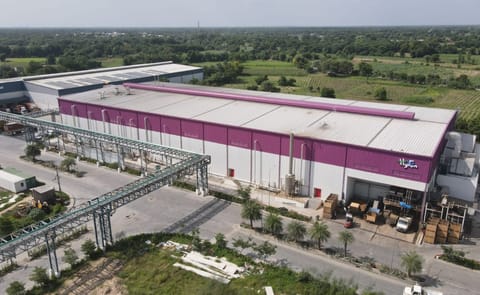Lamb Weston Reports Fiscal Third Quarter 2021 Results; Provides Update for Fourth Quarter Fiscal Year 2021
Potato Processor Lamb Weston Reports F2021 Q3 Results;

Third Quarter Fiscal 2021 Highlights, as Compared to Third Quarter Fiscal 2020
- Net sales declined 4% to $896 million
- Income from operations declined 38% to $101 million
- Net income declined 41% to $66 million
- Diluted EPS declined 41% to $0.45
- Adjusted EBITDA including unconsolidated joint ventures(1) declined 27% to $167 million
- Paid $34 million in dividends to shareholders
- Repurchased 164,678 shares for $13 million
Fourth Quarter Fiscal 2021 Business Update (for 4 weeks ended March 28, 2021), as Compared to Fourth Quarter Fiscal 2019 Levels (2)
- North America shipments were approximately 90% of fourth quarter fiscal 2019 levels
- Europe shipments were approximately 85% of fourth quarter fiscal 2019 levels
- Other International shipments were approximately 75% of fourth quarter fiscal 2019 levels
Tom Werner, President and CEO:
"We delivered solid sales volumes during the quarter as consumers and full-service restaurant traffic responded favorably to the gradual easing of broad social restrictions as the quarter progressed, as well as to the benefit of relatively mild winter weather for much of the period. However, COVID-19 continued to significantly disrupt our manufacturing and distribution operations across our entire supply chain network, which resulted in higher costs."Q3 2021 Commentary
"In the coming months, we believe the gradual improvement in frozen potato demand will continue to the extent governments further lift social restrictions, and as warmer weather provides more outside dining opportunities. The ongoing disruptive effects of COVID-19 on our supply chain will continue to pressure near-term costs, but should also lessen after vaccines become more widely available for our manufacturing teams and our supply chain partners."
"In addition, we remain optimistic that overall demand in the U.S. will steadily return to pre-pandemic levels around the end of calendar 2021, and that global category growth will resume at historical rates soon thereafter. Our recently-announced investments to construct a new manufacturing facility in China, as well as the expansion of our chopped and formed product capacity in the U.S., underscore our confidence in the long-term health of the global category, as well as our strategy to support the growth of our customers as they continue to expand across our key markets."
Net sales declined $41.5 million to $895.8 million, down 4 percent versus the prior year quarter. Volume declined 6 percent, predominantly reflecting lower demand for frozen potato products outside the home related to government-imposed restrictions on restaurants and other foodservice operations to slow the spread of the COVID-19 virus.
The rate of the decline in shipments improved sequentially as compared to the 14 percent decline that the Company realized during the first half of its fiscal 2021, reflecting the steady recovery in demand, particularly in the Company’s Global segment. Price/mix increased 2 percent, driven primarily by improved price in the Retail and Foodservice segments, and favorable mix in the Retail segment.
Income from operations declined $61.9 million, or 38 percent, to $100.6 million versus the prior year quarter, reflecting lower sales and gross profit, as well as higher selling, general and administrative expenses (“SG&A”). Gross profit declined $53.7 million, driven by lower sales and higher manufacturing and distribution costs.
These higher costs were largely due to incremental costs and inefficiencies related to the COVID-19 pandemic’s effect on the Company’s production, transportation, and warehousing operations. The Company also incurred higher costs in the quarter related to capital, repair and maintenance activities that it delayed at the onset of the pandemic.
In addition, higher manufacturing costs reflected input cost inflation. The decline was partially offset by a $7.5 million change in unrealized mark-to-market adjustments associated with commodity hedging contracts, which includes a $7.2 million gain in the current quarter, compared with a $0.3 million loss related to these items in the prior year quarter.
SG&A increased $8.2 million, largely due to investments to improve the Company’s manufacturing and supply chain operations over the long term, and to a lesser extent, its information technology (“IT”) infrastructure. The IT investments included approximately $1 million of non-recurring expenses, primarily related to consulting expenses associated with a new enterprise resource planning system. The increase in SG&A was partially offset by cost management efforts.
Net income declined $45.3 million, or 41 percent, to $66.1 million versus the prior year quarter, due to a decline in income from operations and a $4.1 million increase in interest expense, which reflects an increase in average total debt resulting from the Company’s actions in late fiscal 2020 and early fiscal 2021 to enhance its liquidity position.
Diluted EPS decreased $0.31 to $0.45, due to a decline in income from operations and higher interest expense.
Adjusted Diluted EPS(1), which excludes the $2.6 million loss related to the withdrawal from a multiemployer pension plan by Lamb-Weston/RDO Frozen (“Lamb Weston RDO”) in the prior year quarter, decreased $0.32 to $0.45.
Adjusted EBITDA including unconsolidated joint ventures(1) declined $60.6 million, or 27 percent, to $167.1 million versus the prior year quarter, driven by a decline in income from operations.
The Company’s effective tax rate(3) in the third quarter fiscal 2021 declined to 19.8 percent, versus 24.3 percent in the prior year period, primarily due to discrete items originating during the third quarter fiscal 2021 and a slightly lower annual effective tax rate. The effective tax rate varies from the U.S. statutory tax rate of 21 percent principally due to the impact of U.S. state taxes, foreign taxes, permanent differences, and discrete items.
Q3 2021 Segment Highlights
Global
Net sales for the Global segment, which is generally comprised of the top 100 North American based quick service (“QSR”) and full service restaurant chain customers as well as all of the Company’s international sales, decreased $8.6 million to $478.5 million, down 2 percent compared to the prior year period. Volume declined 2 percent, reflecting lower demand for frozen potato products outside the home as a result of the pandemic’s negative impact on restaurant and other foodservice-related traffic in some of the Company’s key international markets.
The Company’s shipments to North American chain restaurant customers increased nominally compared to the prior year period, and included the benefit of increased sales volumes of limited time offering products. The segment’s overall 2 percent rate of decline is an improvement from the 12 percent rate of decline that the segment realized during the first half of fiscal 2021 compared to the first half of fiscal 2020, largely due to a recovery in international shipments in the third quarter. Price/mix was flat versus the prior year quarter as favorable price was offset by unfavorable mix.
Global segment product contribution margin decreased $30.0 million to $79.3 million, down 27 percent compared to the prior year period. Higher manufacturing and distribution costs, as well as unfavorable mix, drove the decline.
Foodservice
Net sales for the Foodservice segment, which services North American foodservice distributors and restaurant chains generally outside the top 100 North American based restaurant chain customers, declined $63.5 million to $219.5 million, down 22 percent compared to the prior year period. Volume declined 24 percent due to lower demand for frozen potato products outside the home as a result of the pandemic’s negative impact on traffic at restaurants and non-commercial customers, such as lodging and hospitality, healthcare, schools and universities, sports and entertainment, and workplace environments.
Shipment and order trends improved as the quarter progressed, reflecting the positive and anticipated effect on restaurant traffic, especially at full-service restaurants, of governments easing social restrictions, as well as the benefit of relatively mild winter weather. Price/mix increased 2 percent, reflecting the carryover benefit of a pricing action implemented during the second half of fiscal 2020, partially offset by unfavorable mix as sales of Lamb Weston branded and premium products softened.
Foodservice segment product contribution margin decreased $29.6 million to $70.2 million, down 30 percent compared to the prior year period. Lower sales volumes, higher manufacturing and distribution costs, and unfavorable mix drove the decline, partially offset by favorable price.
Retail
Net sales for the Retail segment, which includes sales of branded and private label products to grocery, mass merchant and club customers in North America, increased $30.3 million to $162.5 million, up 23 percent compared to the prior year period. Volume increased 13 percent as strong growth in shipments of premium and mainstream branded offerings, which have historically comprised approximately 40 percent of the segment’s volume, was partially offset by a decline in shipments of private label products, which reflects incremental losses of certain low-margin private label business. Price/mix increased 10 percent, largely driven by favorable mix from higher sales of branded products.
Retail segment product contribution margin increased $4.3 million to $33.1 million, up 15 percent compared to the prior year period. Favorable mix drove the increase, partially offset by higher manufacturing and distribution costs, and an $0.8 million increase in advertising and promotional expenses.
Equity Method Investment Earnings
Equity method investment earnings from unconsolidated joint ventures in Europe, the U.S., and South America were $11.1 million and $9.8 million for the third quarter of fiscal 2021 and 2020, respectively. Equity method investment earnings included a $2.2 million unrealized gain related to mark-to-market adjustments associated with currency and commodity hedging contracts in the current quarter, compared to a $7.3 million unrealized loss related to these items in the prior year quarter.
In addition, in December 2020, Lamb-Weston/Meijer v.o.f. (“Lamb-Weston/Meijer”) increased its interest in its Russian joint venture from 35.5% to 74.9%, and now consolidates that joint venture in its results. Earnings in the prior year quarter also included a $2.6 million loss related to the withdrawal from a multiemployer pension plan by Lamb Weston RDO.
Excluding the mark-to-market adjustments and the Lamb Weston RDO pension-related comparability item, earnings from equity method investments decreased $10.8 million compared to the prior year period. Lower frozen potato demand in Europe resulting from the continuation of government-imposed restrictions, as well as higher production costs related to the COVID-19 pandemic, largely drove the earnings decline.
Cash Flow and Liquidity
Through the third quarter fiscal 2021, net cash from operating activities was $374.8 million, down $60.9 million versus the prior year period, primarily due to lower earnings. Capital expenditures, including information technology expenditures, were $106.7 million, down $45.3 million versus the prior year period.
During the quarter, the Company paid $33.7 million in cash dividends to shareholders, and repurchased 164,678 shares for $12.7 million, reflecting an average price per purchased share of $77.04.
In March 2021, the Company announced the planned construction of a new french fry processing facility in Ulanqab, Inner Mongolia, China with capacity to produce more than 250 million pounds of frozen french fries and other potato products per year. The new facility will add to the Company’s existing in-country production from its facility in Shangdu, Inner Mongolia, China. The new facility is expected to be completed in the first half of fiscal year 2024 and the investment is expected to be approximately $250 million.
Fourth Quarter Fiscal 2021 Business Update
Set forth below is additional detail on the Company’s shipments for the first four weeks of the fourth quarter fiscal 2021 through March 28, 2021. Because of the severe government-imposed social and business restrictions to slow the spread of COVID-19 and the resulting negative impact on frozen potato shipments during the fourth quarter fiscal 2020, the Company believes a comparison to shipments during the fourth quarter fiscal 2019 provides a more meaningful comparison for readers to understand the current condition of the Company’s business.
- United States: Shipments were approximately 90 percent of fourth quarter fiscal 2019 levels.
- Shipments to large chain restaurant customers, which are composed of QSR and large full-service chain restaurants, were more than 85 percent of fourth quarter fiscal 2019 levels. The Company, which records shipments to these customers in its Global segment, anticipates this rate will largely continue for the remainder of its fiscal 2021 fourth quarter.
- Shipments to customers served by the Company’s Foodservice segment, which includes products ultimately sold to full-service chain and independent restaurants, regional and small QSRs, and non-commercial customers (e.g., lodging and hospitality, healthcare, schools and universities, sports and entertainment, and workplace environments) were approximately 90 percent of fourth quarter fiscal 2019 levels.
The Company believes that its March 2021 shipments include the benefit of customers restocking depleted inventories. As a result, the Company anticipates this rate will largely continue for the remainder of its fiscal 2021 fourth quarter. The Company also expects shipments to non-commercial customers, which have historically comprised approximately 25 percent of the segment, will remain soft for the remainder of its fiscal 2021 fourth quarter. - Shipments to customers served by the Company’s Retail segment were approximately 110 percent of fourth quarter fiscal 2019 levels, driven by strength in the Company’s premium and mainstream branded offerings, partially offset by a decline of private label product shipments, which reflects incremental losses of certain low-margin private label business. The Company believes this rate may gradually decline during the remainder of its fiscal 2021 fourth quarter as the Company expects consumers to increase purchases away from home.
- International:
- Europe: Shipments by the Company’s joint venture, Lamb-Weston/Meijer, were approximately 85 percent of fourth quarter fiscal 2019 levels. The Company anticipates that this rate may soften during the remainder of its fiscal 2021 fourth quarter as governments across parts of Europe have reimposed stricter social restrictions to curb another resurgence of COVID-19.
- Other Key Markets: Shipments to the Company’s key international markets, which are primarily in Asia, Oceania and Latin America, were approximately 75 percent of fourth quarter fiscal 2019 levels, in aggregate. The Company anticipates that shipment rates will gradually improve during the remainder of its fiscal 2021 fourth quarter as governments slowly ease social restrictions, where applicable.
For markets that are currently operating under more lenient government-imposed social restrictions, the Company anticipates that shipment rates will largely continue for the remainder of its fiscal 2021 fourth quarter. Excluding shipments associated with the Company’s unconsolidated joint venture in Argentina, the Company records shipments to these markets in its Global segment.
The Company believes that the possibility of wide availability of government-approved COVID-19 vaccines by mid-calendar 2021 may allow governments to gradually ease broad social restrictions in their respective jurisdictions, which would likely have a favorable impact on restaurant traffic.
While the Company expects to continue to face challenging and volatile operating conditions until the virus is broadly contained, it continues to believe that global restaurant traffic will improve through calendar year 2021. Improvements in global restaurant traffic would, in turn, lead to overall frozen potato demand approaching pre-pandemic levels, on a run-rate basis, by the end of the calendar year.
The Company will continue to prioritize the health and welfare of its employees, maintain product safety, and support its customers as they manage their supply chains and inventories. The Company has taken actions, and will continue to evaluate various options, to lower its cost structure and maximize efficiencies in its manufacturing and commercial operations, including modifying production schedules to rebalance utilization rates across its manufacturing network.
The Company expects that it will continue to incur significant costs as a result of the pandemic’s ongoing impact on its manufacturing, distribution, commercial and functional operations until the COVID-19 virus is broadly contained. These costs may include, but are not limited to: production inefficiencies and labor retention costs arising from modifying production schedules, reducing run-times, and lower overall factory utilization; costs to shut down, sanitize, and restart production facilities after production is impacted by the virus; costs to adopt and maintain enhanced employee safety and sanitation protocols, such as purchasing personal protection and health screening equipment and services; and incremental transportation and warehousing costs.
For all of fiscal 2021, the Company is:
- Reducing its estimate for interest expense, net, to approximately $120 million from its previous estimate of approximately $125 million,
- Reducing its estimate for depreciation and amortization to approximately $185 million from its previous estimate of approximately $190 million, and
- Reducing its estimate for cash used for capital expenditures, excluding acquisitions, to approximately $160 million from its previous estimate of approximately $180 million.
End Notes
(1) Adjusted Diluted EPS and Adjusted EBITDA including unconsolidated joint ventures are non-GAAP financial measures. Please see the discussion of non-GAAP financial measures and the reconciliations at the end of this press release for more information.
(2) This press release provides comparisons of the Company’s third quarter fiscal 2021 financial results with its third quarter fiscal 2020 financial results. However, because of the severe government-imposed social and business restrictions to slow the spread of COVID-19 and the resulting negative impact on frozen potato shipments during the fourth quarter fiscal 2020, for purposes of the Company’s business update for the 4 weeks ended March 28, 2021, the Company believes a comparison to shipments during the fourth quarter fiscal 2019 provides a more meaningful comparison for readers to understand the current condition of the Company’s business.
(3) The effective tax rate is calculated as the ratio of income tax expense to pre-tax income, inclusive of equity method investment earnings.
(4) For more information about product contribution margin, please see “Non-GAAP Financial Measures” and the table titled “Segment Information” included in this press release.












